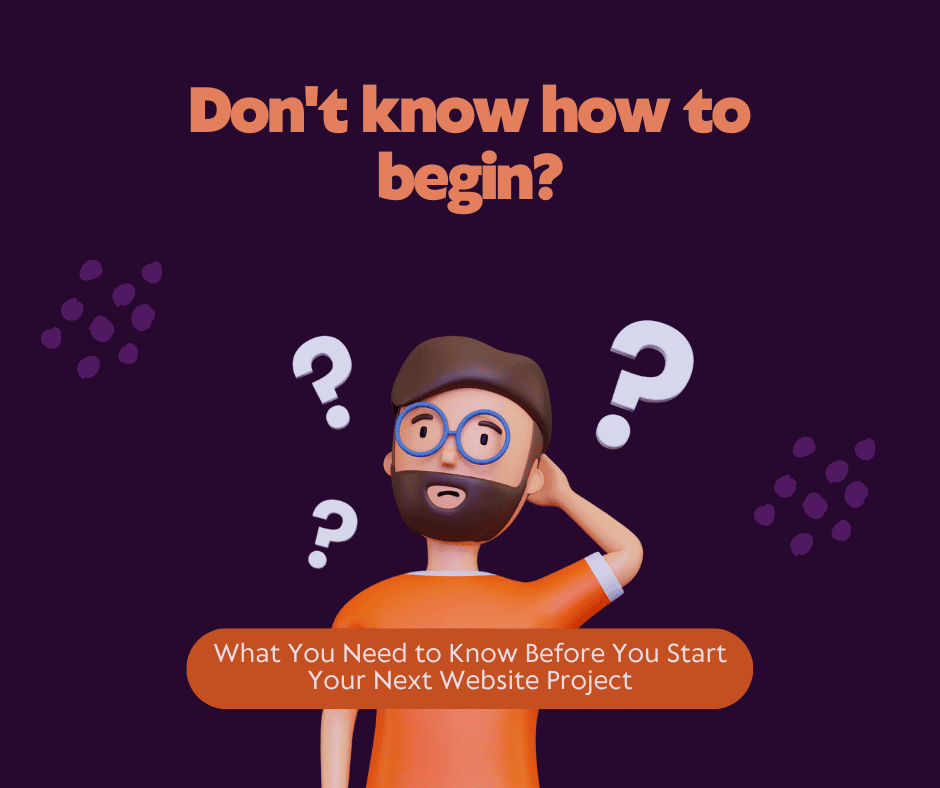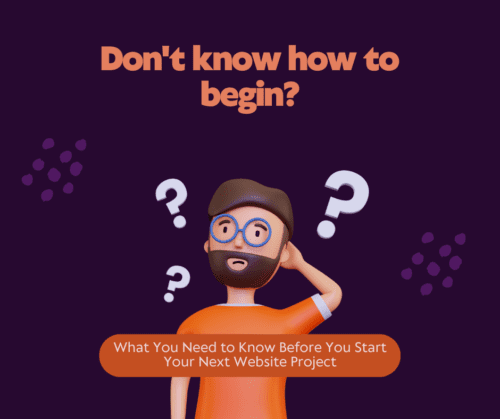What You Need to Know Before You Start Your Next Website Project
What You Need to Know Before You Start Your Next Website Project
After mapping out your business’ brand-image or building your own portfolio, you feel it’s time to take the next step and launch your own website. With the seemingly endless selection of website builders and tools available, it shouldn’t be that hard, right? All of your colleagues seem to have a website, so it’s definitely not an impossible feat… Right?

Well, there’s a lot more that takes place behind the scenes when launching your own website that can certainly make it feel impossible. It’s not wise to just dive right in, as you’ll end up paying for a server without having any content to upload or even a layout for your website.
Before launching your own website, you need to regroup and reorganize your thoughts:
- What are your goals for your website?
- Do you know what you want to say on your website?
- What are your expectations?
- Are you looking for a partner or an order taker?
- How much time and energy are you willing to commit?
Nevertheless, there’s no need to fret. We at Peak Performance Digital are here to help guide you through the daunting process of launching your website.
Have Goals For Your Website
First and foremost, consider why you’re launching a website in the first place. Are you looking to generate more customers for your business, build your brand, assist your sales team, or do you have another goal in mind? How do you see a website benefiting you and your business?
Next, figure out who your audience members are likely to be. Is your target demographic married couples in their mid-thirties to early-fifties? Or, are they single, college-aged individuals? Having a clear picture of who your target audience is will help you communicate your value to your prospects and will shape your digital marketing strategies. After all, what appeals to a college-aged individual might not strike the same chord with someone 10 years their senior (or someone old enough to be their parent).
Draft Your Message
What are you looking to broadcast on to the worldwide web? What is at the heart of your brand voice and how will it connect with your target audience?
Blogging is a major part of digital marketing due to search engine optimization. SEO involves using keywords and links throughout your website to help search engines find and deliver your content to those who are browsing the website. Implementing SEO strategies is the most effective path to the front page of search results.
Even if you don’t feel a blog is central to your website, you’ll need to draft content for the pages on your website and SEO will invariably come in handy. Do you have what it takes to be your own copywriter, or will you need to hire someone to do handle the workload? Going the DIY-route will cost you a lot of time, whereas hiring a copywriter will cost you quite a pretty penny.
Some copywriters will charge an hourly-fee, whereas others could charge per blog post. On average, Clear Voice says professional copywriters charge about $0.26 to $0.50 per word, or $81 to $100 per hour. If you need a copywriter, this is a major aspect to factor into the budget for your website.
Know Your Expectations
Simply building a website and uploading content all willy-nilly won’t do anything to benefit you or your brand unless you intend to drive traffic to your site. Luckily, there are many ways to drive traffic to your website, and many of the solutions are free.
In addition to SEO strategies, clever content marketing on social media can be a huge driver for traffic. 3.5 billion people are on social media, which is approximately 45 percent of the global population, according to Oberlo. Moreover, these individuals spend about three hours a day on social media platforms and 49 percent of them depend on social media influencers to recommend new products to them. 71 percent of customers who have a positive experience with a brand on social media are likely to recommend the brand to their friends and family.
Needless to say, social media marketing is a cornerstone of building your brand. Consistency is key to gaining and retaining new followers online, but posting one to three times a day can be a real time-sucker. Although you could hire a social media manager, you can also pay to advertise on Google and Facebook, which will drive traffic to your website.
Again, it comes down to what resources you’re willing to allocate to digital marketing: would you rather it cost you time or money?
Building Your Team
Would you rather have a partner on your side or an order taker? A partner serves as a second set of eyes and another mind to bounce ideas off of. They’ll help guide you through the process and navigate through the pitfalls to steer you towards success. Additionally, a partner will tell you when your ideas might be a little off and help you form a more effective plan.
On the other hand, an order taker will simply follow through with any tasks you propose to them, regardless of whether it’s the right solution. They don’t have the same executive responsibilities as a partner because it’s not in their job description.
It’s a matter of preference but still a vital decision to make. If this is your first time launching a website and digital marketing sounds entirely foreign to you, it’s wise to consider taking on a partner, rather than an order taker.
Committing to Your Website
How much energy and time are you willing to commit to your website? Launching a website is time-consuming and requires a great deal of effort on behalf of the business and the vendor. If you’re building and managing your own website, content, and social media, it can feel like a 24/7 job.
Even the best website designers, consultants, copywriters, and social media managers won’t be able to speak on behalf of the business as well as you can, so you’ll still need to be an active part of the process. Be prepared to participate in interviews, weekly meetings, and to provide feedback in a timely manner so everything can stay on track.
In Conclusion
There’s far more that goes into launching a website than simply purchasing a domain and a server. Content doesn’t appear out of thin air and digital marketing doesn’t happen by itself. You’ll need to roll up your sleeves and dive deep into the process, from mapping out your goals to deciding how committed you can be to your website.
Although launching a website may seem intimidating, we at Peak Performance Digital are here to help. Peak Performance Digital prides itself on being a strategic partner with our clients. We guide our clients through answering the important questions and creating a website strategy that helps you earn more business and communicate more effectively with your ideal customers.
To learn more about Peak Performance Digital and our services, please contact us.
Recent Posts
About the Recent WordPress Drama
As many of you have heard, there is some drama in the WordPress space right now. If you haven’t heard anything yet, consider yourself lucky to have avoided the needless drama so far. In this post, I’ll cover what is happening, who is impacted, why it’s important, how we are protecting you, and some thoughts […]
Using Sass with Pinegrow
I recently had someone ask whether Pinegrow supports Sass, so I thought I’d do a quick video demonstration. In this demo, I show you how we activate our Sass stylesheet and how we can use a simple Sass variable to change the color of a heading.
Pinegrow Countdown: Day 1 – Pinegrow Plays Nice with Others
A lot of products in the WordPress space have grown in popularity, primarily because of their open and flexible ecosystem that allows 3rd party developers to create add-ons, extensions, and libraries. Pinegrow also has a great plugin API. But I’m going to show you in this video, that in most cases, you don’t even need it.
Pinegrow Countdown: Day 2 – Pinegrow is STILL not a Page Builder
In this video, I’m going to show you why Pinegrow is different from Page Builders so you don’t fall into the trap of trying to use it like something it’s not, only to get frustrated and give up.
Pinegrow Countdown: Day 3 – Frameworks in Pinegrow
Pinegrow has built some fantastic helpers for popular frameworks. In fact, when you start a new project in either Pinegrow Desktop or the Pinegrow WordPress plugin, you’ll be asked which framework you want to choose. If you are already used to using one of the built-in frameworks, the choice will be easy. If not, this little video will hopefully help you understand what the frameworks do and how you should answer those important initial questions.



